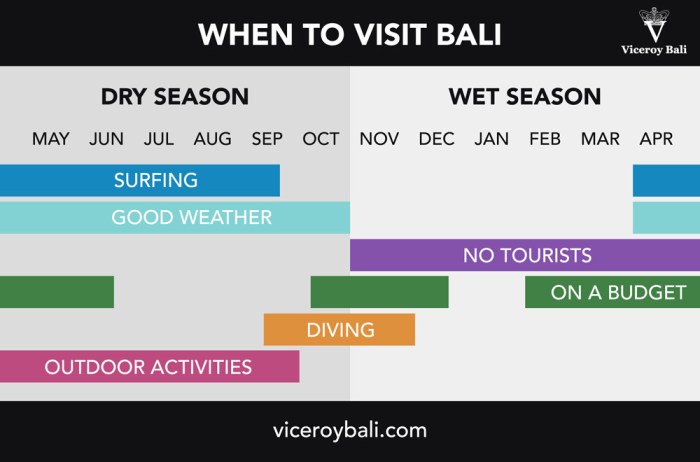Embark on a journey to discover the best time to travel to Bali, an enchanting Indonesian paradise where nature’s wonders intertwine with rich cultural heritage. Whether you seek tranquility amidst pristine beaches, cultural immersion in ancient temples, or exhilarating outdoor adventures, this guide will illuminate the optimal time to experience Bali’s myriad charms.
Throughout the year, Bali’s seasons and events paint a vibrant tapestry, each offering unique experiences. From the vibrant summer months to the serene rainy season, there’s a perfect time to visit that aligns with your travel preferences and desires.
Seasonality and Weather Patterns
Bali experiences two distinct seasons: the wet season and the dry season. The wet season typically lasts from October to April, while the dry season runs from May to September. During the wet season, Bali receives significant rainfall, with an average of over 200mm of rain per month.
The dry season is characterized by much less rainfall, with an average of less than 100mm of rain per month.
The average temperature in Bali remains relatively constant throughout the year, with an average temperature of around 28 degrees Celsius. However, the humidity levels can vary significantly, with higher humidity levels during the wet season and lower humidity levels during the dry season.
Best Time to Visit
The best time to visit Bali depends on your weather preferences. If you prefer to avoid the rain, then the dry season (May to September) is the best time to visit. However, if you are on a budget, the wet season (October to April) can be a great time to visit as there are often discounts on accommodation and activities.
Crowds and Tourism

Bali experiences distinct tourist seasons that influence the number of visitors and the overall travel experience. Understanding these seasons can help travelers plan their trips to avoid crowds or embrace the lively atmosphere.
Peak Season
Bali’s peak season runs from July to August, coinciding with the European summer holidays and school breaks. During this time, the island welcomes a surge of tourists, leading to increased crowds and higher prices. Accommodation becomes more expensive and popular attractions have longer wait times.
Shoulder Season
The shoulder seasons, which fall in May-June and September-October, offer a balance between fewer crowds and pleasant weather. Accommodation rates are typically lower, and attractions are less crowded, providing a more relaxed and immersive travel experience.
Low Season, Best time to travel to bali
Bali’s low season, from November to April, coincides with the rainy season. While rainfall can be unpredictable, it often brings cooler temperatures and fewer tourists. This can be an ideal time to visit for those seeking tranquility and budget-friendly options.
Strategies for Managing Crowds
- Plan your trip during the shoulder or low season to avoid peak crowds.
- Book accommodations and tours in advance, especially during peak season.
- Consider visiting less popular attractions or exploring quieter areas of the island.
- Be prepared for longer wait times at popular attractions and allow extra time in your itinerary.
- Embrace the lively atmosphere and engage with the local culture.
Cultural Events and Festivals

Bali’s vibrant culture is reflected in its numerous festivals and events held throughout the year. These celebrations provide an immersive experience, allowing visitors to witness traditional ceremonies, performances, and art exhibitions.
Major Cultural Events
- Nyepi (Day of Silence): A day of meditation and reflection, observed with complete silence, no lights, and no activities.
- Galungan: A ten-day festival celebrating the victory of good over evil, featuring elaborate temple ceremonies and feasts.
- Kuningan: The final day of Galungan, when offerings are made to honor the ancestors.
- Ubud Writers & Readers Festival: A literary event showcasing renowned authors, workshops, and discussions.
- Bali Arts Festival: A month-long celebration of traditional Balinese dance, music, and art performances.
These festivals enhance the travel experience by providing a glimpse into Bali’s rich cultural heritage. They offer opportunities to interact with locals, learn about customs, and witness the beauty of traditional arts.
Impact on Accommodation
During major festivals, accommodation availability and prices may be affected. It is advisable to book in advance to secure accommodations. However, the increased demand also brings a lively atmosphere and opportunities to connect with other travelers sharing the festival experience.
Transportation and Accessibility

Bali offers various transportation options, including flights, ferries, and local transportation. The time of year can affect transportation schedules and prices. For efficient and affordable travel, consider the following tips:
Flights
Bali’s Ngurah Rai International Airport (DPS) is the main gateway to the island. Numerous airlines offer domestic and international flights. Peak season (July-August) and holidays bring higher airfares.
Bali is a great destination to visit year-round, but if you’re looking for the best weather, plan your trip for September. The shoulder season between the dry and rainy seasons offers pleasant temperatures and fewer crowds. And if you’re looking for more travel inspiration, be sure to check out our guide to the best places to travel in September.
Back to Bali, September is also a great time to catch some waves, as the surf is typically at its best during this time of year.
Ferries
Ferries connect Bali to neighboring islands like Java, Lombok, and the Gili Islands. Schedules and fares vary depending on the route and time of year.
Local Transportation
Bali’s local transportation includes taxis, ride-hailing services, buses, and motorbikes. Taxis are widely available but can be expensive. Ride-hailing apps like Grab and Gojek offer affordable alternatives. Buses are an economical option, but routes and schedules may be limited. Motorbike rentals are popular, but require caution due to Bali’s busy traffic.
When planning a trip to Bali, consider visiting during the dry season (April-October) for optimal weather conditions. If your travel plans align with September, you’ll have the opportunity to explore other captivating destinations with favorable weather during that month. For inspiration, check out our guide to the best places to travel in September.
Upon your return to Bali, you’ll appreciate the island’s pristine beaches and lush landscapes even more.
End of Discussion

In conclusion, the best time to travel to Bali hinges on your individual preferences and the experiences you seek. Whether you crave sun-kissed beaches, cultural immersion, or adventure-filled escapades, Bali’s diverse seasons and events offer something for every traveler. Embrace the island’s charm during the lively summer months, seek tranquility in the rainy season, or immerse yourself in cultural festivities throughout the year.
Plan your journey wisely, and Bali will unveil its enchanting beauty, leaving you with memories that will last a lifetime.
FAQ Insights: Best Time To Travel To Bali
When is the best time to visit Bali for surfing?
Bali’s consistent waves make it a surfer’s paradise year-round, but the best swells typically occur during the dry season (April to October).
What is the rainy season in Bali like?
Bali’s rainy season (November to March) brings lush greenery and fewer crowds, offering a unique opportunity to experience the island’s natural beauty in tranquility.
Are there any major festivals in Bali?
Bali is renowned for its vibrant cultural festivals, including Nyepi (Day of Silence), Galungan (ancestral spirits’ return), and Kuningan (day of forgiveness).